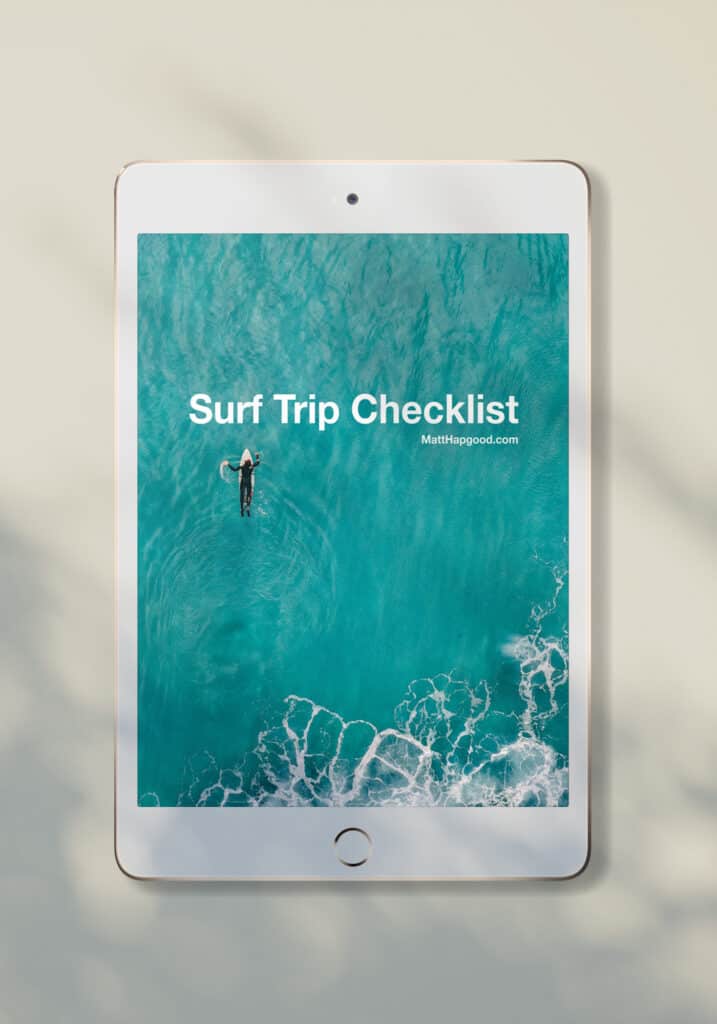The Best Beginner Surf Spots in Portugal
Last Updated on June 14, 2024 by Matt Hapgood
Portugal is renowned for its diverse coastline that caters to surfers of all skill levels, but it truly shines as an awesome beginner surfing destination.
And while Portugal is home to the World’s biggest waves at Nazare, there are a tonne of spots up and down the coast really well suited to surfers just starting out.
As a blow in to Portugal 5 years ago, I’ll share some of the best spots to visit, whether you just want to surf, or soak up a bit of culture too.
Let’s rip in!
Top Beginner Surf Spots in Portugal
Portugal’s extensive coastline boasts an array of surf spots that cater to beginners, featuring gentle waves, sandy bottoms, and surf schools nearby.

Lisbon Coast
On the Lisbon Coast, Carcavelos Beach offers waves that are perfect for those just starting out. The beach break here is consistent, providing manageable waves with plenty of space to practice. Additionally, local surf schools can guide beginners through their first steps in surfing.
- Beach: Carcavelos Beach
- Features: Consistent waves, Surf schools available
- Best for: Beginners learning to catch and ride waves

Algarve
The warm waters of the Algarve present an inviting environment for beginner surfers. Praia da Rocha near Portimão is particularly ideal for first-time surfers due to its soft waves and wide expanse of sand, easing the learning process.
- Beach: Praia da Rocha
- Advantages: Warm water, Soft waves, Wide sandy beach
- Suitable for: New surfers seeking comfort and space

Porto and the North
The North of Portugal, around Porto, is known for its uncrowded beaches, such as Matosinhos. Here, I find waves well-suited for beginners, especially during summer. Matosinhos beach is also well-equipped with surf shops and schools.

- Beach: Matosinhos Beach
- Highlights: Gentle summer waves, Surf amenities
- Recommended for: Beginners preferring less crowded conditions
Central Portugal
Peniche in Central Portugal is a mecca for surfers, including those who are just starting. The Baleal Beach area is favored for its sheltered bay and mellow waves. It’s also a prime location for those looking to progress with experienced instructors at hand.

- Beach: Baleal Beach, Peniche
- Characteristics: Sheltered bay, Mellow waves, Expert instruction
- Appropriate for: Beginner surfers who are advancing their skills
Essential Surfing Tips for Beginners
Embarking on your surfing journey requires understanding a few fundamental concepts to ensure both your safety and enjoyment while riding the waves.
Choosing the Right Surfboard
When I start surfing, the choice of my surfboard is crucial. As a beginner, I look for a board that is stable, offers good buoyancy, and makes paddling easier. These qualities are typically found in longboards which have a longer and wider build. My first board should be about 8 to 10 feet in length to provide ample stability.
Soft-top surfboards are my recommended choice for their added buoyancy and safety. The core table below summarizes the ideal beginner surfboard characteristics:
| Feature | Ideal Specification for Beginners |
|---|---|
| Length | 8 to 10 feet |
| Width | Generous, for increased stability |
| Thickness | Provides good floatation |
| Material | Soft-top for safety and durability |
Understanding Surf Etiquette
As I join the lineup of surfers, I must be aware of the basic rules that govern surfing etiquette. Right of Way is a pivotal rule; the surfer closest to the breaking wave has the priority to take it. Additionally, it’s essential for me to avoid “dropping in,” which means stealing a wave from a surfer who’s already riding it.
Being respectful to local surfers and the environment is equally important. Keeping clear of other surfers, saying sorry if I make a mistake, and steering clear of littering are practices that promote harmony in the water.
Learning Surf Techniques
Mastering essential surf techniques is foundational to my success in the sport. Paddling effectively is the first step; I must keep my body centered and use my arms in a smooth, alternating motion. Once I’m comfortable with paddling, I move on to practicing the pop-up, which is the transition from lying on the board to standing.
Below are the key techniques I need to focus on:
- Paddling: Keep the body straight; use a cupped hand and a deep, steady stroke.
- Pop-up: Start prone; hands push the torso up; then spring to a low-standing position.
- Standing Position: Feet shoulder-width apart, knees bent, and arms out for balance.
- Turning: Shift weight subtly to the balls of my feet to guide the board’s direction.
By adhering to these key tips, I set myself up for a safer and more enjoyable surfing experience.








